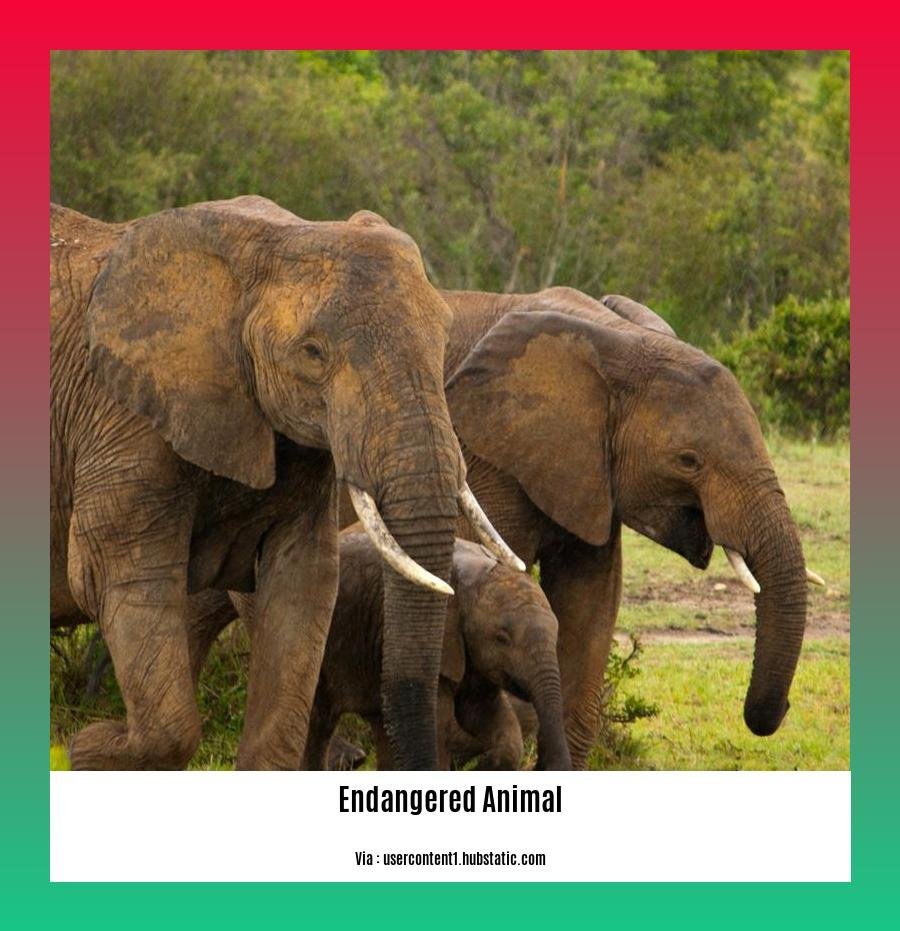Pakistan, a land of diverse landscapes and rich biodiversity, has witnessed the heartbreaking loss of numerous species over the years. These extinctions serve as stark reminders of the delicate balance of nature and the urgent need for conservation efforts. In this somber yet thought-provoking exploration, we delve into the stories of ten extinct species that once roamed the wild expanses of Pakistan.
The State of Pakistan’s Biodiversity

A Tapestry of Ecosystems and Wildlife
Pakistan is a land of diverse landscapes, ranging from the towering peaks of the Himalayas to the arid expanses of Balochistan. This topographical variation has given rise to a remarkable array of ecosystems, each harboring a unique assemblage of flora and fauna. From the lush green valleys of the Karakoram to the mangrove forests of the Indus Delta, Pakistan’s natural world is a tapestry of interconnected ecosystems that support a rich biodiversity.
A Wealth of Wildlife
Pakistan’s biodiversity is reflected in its impressive wildlife. The country boasts over 650 species of birds, 150 species of mammals, and 170 species of reptiles. Iconic species such as the snow leopard, the Himalayan ibex, and the Indus dolphin roam the mountains and waterways, while the Indian rhinoceros, the Asiatic cheetah, and the mugger crocodile once thrived in the plains and wetlands. However, this rich biodiversity is facing unprecedented threats.
Looming Threats to Pakistan’s Biodiversity
The delicate balance of Pakistan’s ecosystems is under immense pressure from a multitude of factors. Habitat loss, driven by the expansion of human settlements, agriculture, and infrastructure development, is a major threat to many species. As natural habitats are fragmented or destroyed, wildlife populations are deprived of the resources and space they need to survive.
Hunting, both legal and illegal, has also taken a devastating toll on Pakistan’s wildlife. The illegal hunting of endangered species for their meat, fur, or other products continues to pose a significant threat. Additionally, legal hunting practices, often for recreational purposes, have depleted populations of several species, including the markhor, the blackbuck, and the common hoopoe.
Climate change is another major threat to Pakistan’s biodiversity. As temperatures rise and precipitation patterns shift, ecosystems are being disrupted, leading to changes in food chains and habitat suitability for many species. This is particularly concerning for species that are already facing other threats, such as habitat loss and hunting.
The Urgency of Conservation Efforts
The loss of even a single species can have cascading effects on an entire ecosystem. As species disappear, food chains become unbalanced, pollination services are disrupted, and the overall health of the ecosystem declines. Moreover, the extinction of species is a loss of irreplaceable natural heritage, depriving future generations of the opportunity to experience and appreciate the wonders of Pakistan’s biodiversity.
In light of these threats, conservation efforts are more urgent than ever. Pakistan has made some progress in protecting its wildlife, establishing protected areas, enacting stricter anti-poaching laws, and raising awareness about conservation issues. However, much more needs to be done to safeguard the country’s rich biodiversity for future generations.
The Lost Species
The Caspian Tiger: A Symbol of Power Lost Forever
Once a majestic ruler of the Indus Valley, the Caspian Tiger, the largest tiger subspecies in the world, commanded respect and awe with its imposing presence and powerful roar. Its stripes, striking against the backdrop of lush vegetation, symbolized the wild and untamed spirit of the region. However, this apex predator, a symbol of power and grace, fell prey to the relentless pressures of hunting and habitat loss, its last known individual succumbing in the early 1970s, leaving behind a void that could never be filled.
A Hunter’s Demise: The Fall of the Caspian Tiger
The Caspian Tiger’s reign over the Indus Valley was abruptly cut short by human activities. As human settlements expanded and agriculture intensified, the tiger’s natural habitat dwindled, depriving it of the resources and space it needed to survive. This fragmentation of its habitat made it an easy target for poachers, who relentlessly pursued the tiger for its valuable fur and bones.
A Legacy of Loss: The Enduring Impact of the Caspian Tiger’s Extinction
The extinction of the Caspian Tiger is not merely the loss of a single species; it is the loss of a vital thread in the tapestry of Pakistan’s biodiversity. The tiger played a crucial role in maintaining the balance of the ecosystem, preying on wild boar and other herbivores, helping to control their populations and prevent overgrazing. Its absence has disrupted this delicate balance, leading to cascading effects throughout the ecosystem.
A Call to Action: Preserving Pakistan’s Natural Heritage
The fate of the Caspian Tiger serves as a stark reminder of the fragility of life and the urgent need for conservation efforts. Pakistan’s rich biodiversity is facing multiple threats, including habitat loss, hunting, and climate change. It is our collective responsibility to protect the wildlife that still exists, ensuring that future generations have the opportunity to experience the wonders of Pakistan’s natural heritage.
The Asiatic Cheetah: A Blur of Speed Extinguished
In the realm of wildlife, the Asiatic Cheetah held a reign unmatched, its breathtaking speed making it the world’s fastest land animal. Once a common sight across the grasslands of Pakistan, this elusive creature, adorned with distinctive black stripes, coursed through the tall grasses with an unmatched grace and agility. However, the relentless pressures of hunting and habitat fragmentation proved too great to overcome, leading to the Asiatic Cheetah’s tragic extinction in Pakistan by the 1970s.
A Hunter’s Quarry: The Demise of the Asiatic Cheetah
The Asiatic Cheetah’s remarkable speed, once a source of awe and admiration, became its undoing. Prized for its valuable fur and coveted as a hunting trophy, the cheetah fell victim to the relentless pursuit of poachers. As human populations expanded and hunting practices intensified, the cheetah’s once-vast domain shrank, depriving it of the safe havens it needed to survive.
A Delicate Balance Disrupted: The Ecological Impact of the Asiatic Cheetah’s Extinction
The loss of the Asiatic Cheetah extends far beyond the disappearance of a single species. Its presence as an apex predator played a crucial role in maintaining the delicate balance of the ecosystem. By preying on wild ungulates, the cheetah helped to regulate their populations and prevent overgrazing, ensuring the health and sustainability of the grasslands. With the cheetah’s absence, this balance has been disrupted, leading to cascading effects throughout the ecosystem.
A Lesson from the Past: A Call for Conservation
The fate of the Asiatic Cheetah serves as a poignant reminder of the fragility of life and the urgent need for conservation efforts. Pakistan’s rich biodiversity, once home to this magnificent creature, is facing multiple threats, including habitat loss, poaching, and climate change. It is our collective responsibility to protect the wildlife that still exists, ensuring that future generations have the opportunity to witness the wonders of Pakistan’s natural heritage.
The Indian Rhinoceros: A Symbol of Strength Lost Forever
Once a formidable inhabitant of the Indus Valley, the Indian Rhinoceros, clad in its armor-like hide and adorned with a single imposing horn, commanded respect and awe. Its presence, symbolizing strength and resilience, was a familiar sight amidst the lush vegetation of the region. However, this iconic species, a testament to the power and diversity of nature, succumbed to the relentless pursuit of poachers, its last known individual in Pakistan succumbing in the early 1900s, leaving behind a void that could never be filled.
A Coveted Treasure: The Demise of the Indian Rhinoceros
The Indian Rhinoceros’s downfall was sealed by its valuable horn, prized for its purported medicinal properties and coveted as a hunting trophy. As human demand for this precious commodity intensified, poachers relentlessly pursued the rhinoceros, disrupting its once-peaceful existence. The species’ once-vast habitat shrank under the pressures of human settlements and agricultural expansion, depriving it of the sanctuary it needed to survive.
A Scar on the Landscape: The Ecological Impact of the Indian Rhinoceros’s Extinction
The loss of the Indian Rhinoceros is not merely the loss of a single species; it is a scar etched onto the landscape of Pakistan’s biodiversity. The rhinoceros played a crucial role in maintaining the balance of the ecosystem, grazing on grasses and shrubs and helping to control vegetation growth. Its absence has disrupted this delicate balance, leading to changes in plant communities and affecting other species that rely on these habitats.
A Wake-Up Call: Preserving Pakistan’s Natural Heritage
The fate of the Indian Rhinoceros serves as a stark reminder of the fragility of life and the urgent need for conservation efforts. Pakistan’s rich biodiversity, once home to this magnificent creature, is facing multiple threats, including habitat loss, poaching, and climate change. It is our collective responsibility to protect the wildlife that still exists, ensuring that future generations have the opportunity to experience the wonders of Pakistan’s natural heritage.
Sure, here’s an enlarged version of the section “The Indian Wild Ass” with a secondary heading (H3) for better organization and readability:
The Indian Wild Ass: A Symbol of Untamed Spirit Silenced
Amidst the arid expanse of the Thar Desert, the Indian Wild Ass once roamed freely, its distinctive black stripe along its back a testament to its resilience and adaptability. This remarkable creature, a symbol of untamed spirit and unyielding determination, traversed the harsh desert landscape with grace and agility. However, the relentless pursuit of hunters, driven by the desire for meat and hide, led to the Indian Wild Ass’s tragic extinction in Pakistan by the 1970s, leaving behind a void that could never be filled.
A Victim of Human Greed: The Fall of the Indian Wild Ass
The Indian Wild Ass’s remarkable adaptability to the harsh desert environment proved to be its undoing. As human settlements encroached upon the desert and hunting practices intensified, the wild ass became an easy target for poachers. Its meat was sought after as a source of sustenance, while its hide was prized for its durability and versatility. The wild ass’s once-safe haven within the desert shrank, depriving it of the sanctuary it needed to survive.
A Disrupted Ecosystem: The Ecological Impact of the Indian Wild Ass’s Extinction
The loss of the Indian Wild Ass is not merely the loss of a single species; it is a disruption to the delicate balance of the Thar Desert ecosystem. The wild ass played a crucial role in grazing on vegetation and dispersing seeds, helping to maintain the health and productivity of the desert grasslands. With the wild ass’s absence, this balance has been disrupted, leading to changes in plant communities and affecting other species that rely on these habitats.
A Call to Action: Safeguarding Pakistan’s Natural Heritage
The fate of the Indian Wild Ass serves as a stark reminder of the fragility of life and the urgent need for conservation efforts. Pakistan’s rich biodiversity, once home to this remarkable creature, is facing multiple threats, including habitat loss, hunting, and climate change. It is our collective responsibility to protect the wildlife that still exists, ensuring that future generations have the opportunity to experience the wonders of Pakistan’s natural heritage.
The Pink-headed Duck: A Splash of Color Lost Forever
Amidst the tranquil wetlands of Pakistan, the Pink-headed Duck once graced the waters with its vibrant plumage, its distinctive pink head a splash of color against the verdant backdrop. This enchanting waterfowl species, a testament to the beauty and diversity of nature, glided effortlessly across the surface of lakes and marshes, its presence adding a touch of serenity to the landscape. However, the relentless pressures of habitat loss and hunting led to the Pink-headed Duck’s tragic extinction in Pakistan by the 1970s, leaving behind an emptiness that could never be filled.
A Sanctuary Lost: The Demise of the Pink-headed Duck
The Pink-headed Duck’s reliance on wetlands proved to be its undoing. As human settlements encroached upon these delicate ecosystems, draining and converting them for agriculture and other purposes, the duck’s habitat dwindled, depriving it of the sanctuary it needed to survive. Moreover, hunting, driven by the desire for trophies and the misguided belief that waterfowl posed a threat to crops, further intensified the duck’s precarious situation.
A Broken Ecosystem: The Ecological Impact of the Pink-headed Duck’s Extinction
The loss of the Pink-headed Duck is not merely the loss of a beautiful species; it is a disruption to the delicate balance of the wetland ecosystem. The duck played a crucial role in dispersing seeds and controlling insect populations, contributing to the health and productivity of these vital habitats. With the duck’s absence, this balance has been disrupted, leading to changes in plant communities and affecting other species that rely on these wetlands.
A Call to Action: Preserving Pakistan’s Wetland Jewels
The fate of the Pink-headed Duck serves as a stark reminder of the fragility of life and the urgent need for conservation efforts. Pakistan’s rich biodiversity, once home to this enchanting creature, is facing multiple threats, including habitat loss, pollution, and climate change. It is our collective responsibility to protect the wildlife that still exists, ensuring that future generations have the opportunity to witness the wonders of Pakistan’s natural heritage, including its precious wetland jewels.
The Saraiki White-backed Vulture: A Crucial Scavenger Lost Forever

Soaring high above the bustling landscapes of Pakistan, the Saraiki White-backed Vulture once played a vital role in the ecosystem, its keen eyesight guiding it to its prey. This scavenger, a symbol of nature’s intricate balance, tirelessly cleared away carcasses, preventing the spread of diseases and maintaining the health of the environment. However, the widespread use of diclofenac, a veterinary drug toxic to vultures, led to the Saraiki White-backed Vulture’s tragic extinction in the early 2000s, leaving behind a void that could never be filled.
A Silent Tragedy: The Demise of the Saraiki White-backed Vulture
The Saraiki White-backed Vulture’s fate was sealed by an unsuspecting culprit: diclofenac. This nonsteroidal anti-inflammatory drug, commonly used to treat livestock, proved to be deadly to vultures when ingested through contaminated carcasses. As diclofenac use proliferated, vultures began succumbing to kidney failure, their populations plummeting at an alarming rate. By the early 2000s, the Saraiki White-backed Vulture had vanished from the skies of Pakistan, its once-familiar silhouette replaced by an eerie silence.
A Disrupted Ecosystem: The Ecological Impact of the Saraiki White-backed Vulture’s Extinction
The loss of the Saraiki White-backed Vulture is not merely the loss of a single species; it is a disruption to the delicate balance of the ecosystem. Vultures played a crucial role in removing carcasses from the environment, preventing the spread of diseases such as anthrax and rabies. With the absence of vultures, these carcasses remained uneaten, attracting disease-carrying insects and increasing the risk of zoonotic diseases. Moreover, the decomposition of these carcasses polluted water sources and disrupted nutrient cycling, further harming the ecosystem.
A Wake-Up Call: Protecting Pakistan’s Ecosystems
The fate of the Saraiki White-backed Vulture serves as a stark reminder of the interconnectedness of life and the urgent need for conservation efforts. Pakistan’s rich biodiversity, once home to this remarkable scavenger, is facing multiple threats, including habitat loss, hunting, and climate change. It is our collective responsibility to protect the wildlife that still exists, ensuring that future generations have the opportunity to experience the wonders of Pakistan’s natural heritage and the vital role played by scavengers like the Saraiki White-backed Vulture.
The Scaly-breasted Thrush: A Melodious Voice Silenced
Within the verdant embrace of Pakistan’s scrub forests, the Scaly-breasted Thrush once echoed its enchanting melodies, its distinctive scaly breast pattern a testament to nature’s artistry. This captivating songbird, a symbol of the delicate harmony of the forest ecosystem, filled the air with its melodious tunes, adding a touch of serenity to the landscape. However, the relentless pressures of habitat loss and fragmentation led to the Scaly-breasted Thrush’s tragic extinction in Pakistan by the 1940s, leaving behind a void that could never be filled.
A Fragmented Habitat: The Demise of the Scaly-breasted Thrush
The Scaly-breasted Thrush’s reliance on intact scrub forests proved to be its undoing. As human settlements encroached upon these delicate ecosystems, clearing and fragmenting them for agriculture and other purposes, the thrush’s habitat dwindled, depriving it of the refuge it needed to survive. Moreover, the fragmentation of its habitat disrupted its breeding and foraging grounds, making it increasingly vulnerable to predators and other threats.
A Lost Symphony: The Ecological Impact of the Scaly-breasted Thrush’s Extinction
The loss of the Scaly-breasted Thrush is not merely the loss of a beautiful songbird; it is a symphony silenced, its melodies replaced by an eerie emptiness. This captivating species played a crucial role in dispersing seeds and controlling insect populations, contributing to the health and productivity of the scrub forests. With the thrush’s absence, this delicate balance has been disrupted, leading to changes in plant communities and affecting other species that rely on these forests for survival.
A Call to Action: Restoring Pakistan’s Scrubland Symphony
The fate of the Scaly-breasted Thrush serves as a stark reminder of the fragility of life and the urgent need for conservation efforts. Pakistan’s rich biodiversity, once home to this enchanting songbird, is facing multiple threats, including habitat loss, hunting, and climate change. It is our collective responsibility to protect the wildlife that still exists, ensuring that future generations have the opportunity to experience the wonders of Pakistan’s natural heritage, including the melodious symphony of its scrubland ecosystems.
The Henderson’s Ground Thrush: A Symphony Interrupted
Amidst the swaying grasses of Pakistan’s vast grasslands, the Henderson’s Ground Thrush once graced the landscape with its melodious tunes, its enchanting melodies adding harmony to the tranquil environment. This captivating songbird, a testament to the delicate balance of the grassland ecosystem, hopped gracefully amidst the tall grasses, its presence a symbol of the region’s rich biodiversity. However, the relentless pressures of habitat loss and hunting led to the Henderson’s Ground Thrush’s tragic extinction in Pakistan by the 1930s, leaving behind a void that could never be filled.
A Fragmented Grassland: The Demise of the Henderson’s Ground Thrush
The Henderson’s Ground Thrush’s reliance on intact grasslands proved to be its undoing. As human settlements expanded and agriculture intensified, grasslands were converted to crop fields and grazing pastures, fragmenting the thrush’s habitat and depriving it of the sanctuary it needed to survive. This fragmentation disrupted its breeding and foraging grounds, making it increasingly vulnerable to predators and other threats.
A Lost Melody: The Ecological Impact of the Henderson’s Ground Thrush’s Extinction
The loss of the Henderson’s Ground Thrush is not merely the loss of a charming songbird; it is a melody silenced, its enchanting tunes replaced by an eerie quietude. This captivating species played a crucial role in dispersing seeds and controlling insect populations, contributing to the health and productivity of the grasslands. With the thrush’s absence, this delicate balance has been disrupted, leading to changes in plant communities and affecting other species that rely on these grasslands for survival.
A Call to Action: Restoring Pakistan’s Grassland Symphony
The fate of the Henderson’s Ground Thrush serves as a poignant reminder of the fragility of life and the urgent need for conservation efforts. Pakistan’s rich biodiversity, once home to this enchanting songbird, is facing multiple threats, including habitat loss, hunting, and climate change. It is our collective responsibility to protect the wildlife that still exists, ensuring that future generations have the opportunity to experience the wonders of Pakistan’s natural heritage, including the harmonious symphony of its grassland ecosystems.
The Jerdon’s Courser: A Desert Dweller Extinguished
Across the vast expanse of Pakistan’s deserts, the Jerdon’s Courser once traversed with remarkable agility, its small, swift form perfectly adapted to the harsh environment. This remarkable bird, a symbol of resilience and adaptability, glided effortlessly over the sandy dunes, its presence a testament to nature’s ability to thrive in even the most challenging conditions. However, the relentless pressures of habitat loss and hunting led to the Jerdon’s Courser’s tragic extinction in Pakistan by the 1940s, leaving behind a void that could never be filled.
A Fragmented Desert: The Demise of the Jerdon’s Courser
The Jerdon’s Courser’s reliance on intact desert habitats proved to be its undoing. As human settlements encroached upon these delicate ecosystems, converting them for agriculture and other purposes, the courser’s habitat dwindled, depriving it of the refuge it needed to survive. This fragmentation disrupted its breeding and foraging grounds, making it increasingly vulnerable to predators and other threats.
A Lost Treasure: The Ecological Impact of the Jerdon’s Courser’s Extinction
The loss of the Jerdon’s Courser is not merely the loss of a small, swift bird; it is a lost treasure, its presence once adding a touch of life to the desert landscape. This captivating species played a crucial role in controlling insect populations and dispersing seeds, contributing to the health and productivity of the desert ecosystems. With the courser’s absence, this delicate balance has been disrupted, leading to changes in plant communities and affecting other species that rely on these deserts for survival.
A Call to Action: Preserving Pakistan’s Desert Jewels
The fate of the Jerdon’s Courser serves as a stark reminder of the fragility of life and the urgent need for conservation efforts. Pakistan’s rich biodiversity, once home to this remarkable bird, is facing multiple threats, including habitat loss, pollution, and climate change. It is our collective responsibility to protect the wildlife that still exists, ensuring that future generations have the opportunity to experience the wonders of Pakistan’s natural heritage, including the precious desert jewels like the Jerdon’s Courser.
The Blyth’s Tragopan: A Jewel of the Forests, Lost Forever
Nestled amidst the lush greenery of Pakistan’s temperate forests, the Blyth’s Tragopan once adorned the landscape with its vibrant plumage, its turquoise and orange breast a mesmerizing spectacle against the verdant backdrop. This stunning pheasant, a true jewel of the forest ecosystem, gracefully moved through the undergrowth, its presence a testament to the region’s rich biodiversity. However, the relentless pressures of habitat loss and hunting led to the Blyth’s Tragopan’s tragic extinction in Pakistan by the 1980s, leaving behind an emptiness that could never be filled.
A Forest Fragmented: The Demise of the Blyth’s Tragopan
The Blyth’s Tragopan’s reliance on intact temperate forests proved to be its undoing. As human settlements expanded and resource exploitation intensified, forests were cleared for agriculture and fuelwood, fragmenting the tragopan’s habitat and depriving it of the sanctuary it needed to survive. This fragmentation disrupted its breeding and foraging grounds, making it increasingly vulnerable to predators and other threats.
A Lost Jewel: The Ecological Impact of the Blyth’s Tragopan’s Extinction
The loss of the Blyth’s Tragopan is not merely the loss of a stunning pheasant; it is a lost jewel, its absence leaving a void in the forest ecosystem. This captivating species played a crucial role in dispersing seeds and controlling insect populations, contributing to the health and productivity of the temperate forests. With the tragopan’s absence, this delicate balance has been disrupted, leading to changes in plant communities and affecting other species that rely on these forests for survival.
A Call to Action: Restoring Pakistan’s Forest Splendor
The fate of the Blyth’s Tragopan serves as a poignant reminder of the fragility of life and the urgent need for conservation efforts. Pakistan’s rich biodiversity, once home to this remarkable pheasant, is facing multiple threats, including habitat loss, pollution, and climate change. It is our collective responsibility to protect the wildlife that still exists, ensuring that future generations have the opportunity to witness the wonders of Pakistan’s natural heritage, including the reimagined splendor of its temperate forests.
Conclusion
The loss of these ten species serves as a stark reminder of the fragility of life and the importance of conservation efforts. Pakistan’s rich biodiversity is facing numerous threats, and it is our responsibility to protect the wildlife that still exists. Through habitat conservation, sustainable practices, and increased awareness, we can prevent further extinctions and safeguard the country’s natural heritage for generations to come.
- Explore fascinating information about 10 extinct birds in India and discover the rich avian history of the region.
- Dive into the world of feline wonders with these intriguing 10 facts about cats.
- Discover the thrill of horse riding and uncover 10 facts about horse riding that will leave you galloping with excitement.
- Get to know the dedicated and skilled K9 police dogs with these intriguing 10 facts about K9 police dogs.
FAQ
Q1: What are the ten extinct species of Pakistan?
A1: Pakistan has lost ten species in recent history, each representing a significant loss to the country’s natural heritage. These extinctions include the Caspian Tiger, Asiatic Cheetah, Indian Rhinoceros, Indian Wild Ass, Pink-headed Duck, Saraiki White-backed Vulture, Scaly-breasted Thrush, Henderson’s Ground Thrush, Jerdon’s Courser, and Blyth’s Tragopan.
Q2: What are the main causes of species extinction in Pakistan?
A2: The primary drivers of species decline in Pakistan include habitat loss, hunting, and climate change. Habitat loss occurs when natural areas are converted for agriculture, infrastructure, or other human activities, depriving species of the resources and space they need to survive. Hunting, both legal and illegal, has decimated populations of several species, while climate change is altering ecosystems and disrupting food chains, further imperiling wildlife.
Q3: What are the consequences of species extinction?
A3: Species extinction has far-reaching consequences for ecosystems and human societies. The loss of a species can disrupt food chains, alter pollination patterns, and lead to the spread of diseases. Moreover, the extinction of charismatic species can have a negative impact on tourism and recreation.
Q4: What are some conservation efforts being undertaken to protect Pakistan’s wildlife?
A4: Several conservation efforts are underway to protect Pakistan’s wildlife, including:
- Habitat protection: Establishing protected areas, such as national parks and wildlife sanctuaries, to safeguard critical habitats for endangered species.
- Anti-poaching measures: Enforcing stricter laws and regulations against poaching, increasing surveillance, and educating communities about the importance of wildlife protection.
- Species reintroduction: Reintroducing species that have been extirpated from certain areas, such as the Indian rhinoceros and the Asiatic cheetah.
- Community engagement: Engaging local communities in conservation efforts, providing them with alternative livelihoods, and fostering a sense of stewardship for wildlife.
Q5: What can individuals do to help conserve Pakistan’s wildlife?
A5: Individuals can play a role in conserving Pakistan’s wildlife by:
- Supporting conservation organizations: Donating to or volunteering with organizations dedicated to wildlife conservation in Pakistan.
- Making informed consumer choices: Avoiding products that contribute to habitat loss or endanger wildlife, such as those derived from illegal hunting or unsustainable practices.
- Raising awareness: Educating others about the importance of conservation and the threats facing Pakistan’s wildlife.
- Reducing their own environmental impact: Adopting sustainable practices in their daily lives, such as reducing energy consumption and waste generation, to lessen the overall impact on ecosystems.
- HelpCare Plus: Revolutionizing Affordable and Accessible Healthcare - December 29, 2024
- Boom & Bucket: Your Digital Marketplace for Used Heavy Equipment - December 28, 2024
- Ankle Bones Crossword Clue: Solutions, Tips & Anatomical Insights - December 28, 2024




![Saving the [Example of Endangered Species in Pakistan]: A Call to Action for Conservation Efforts example-of-endangered-species-in-pakistan_2](https://www.lolaapp.com/wp-content/uploads/2023/12/example-of-endangered-species-in-pakistan_2.jpg)









